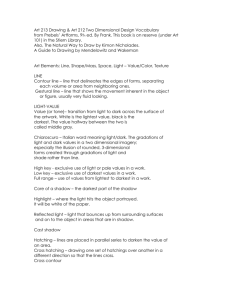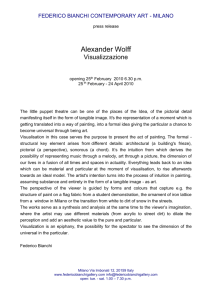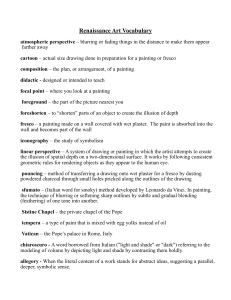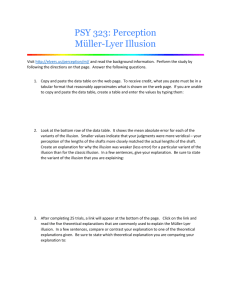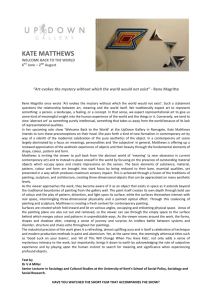full artist statement
advertisement
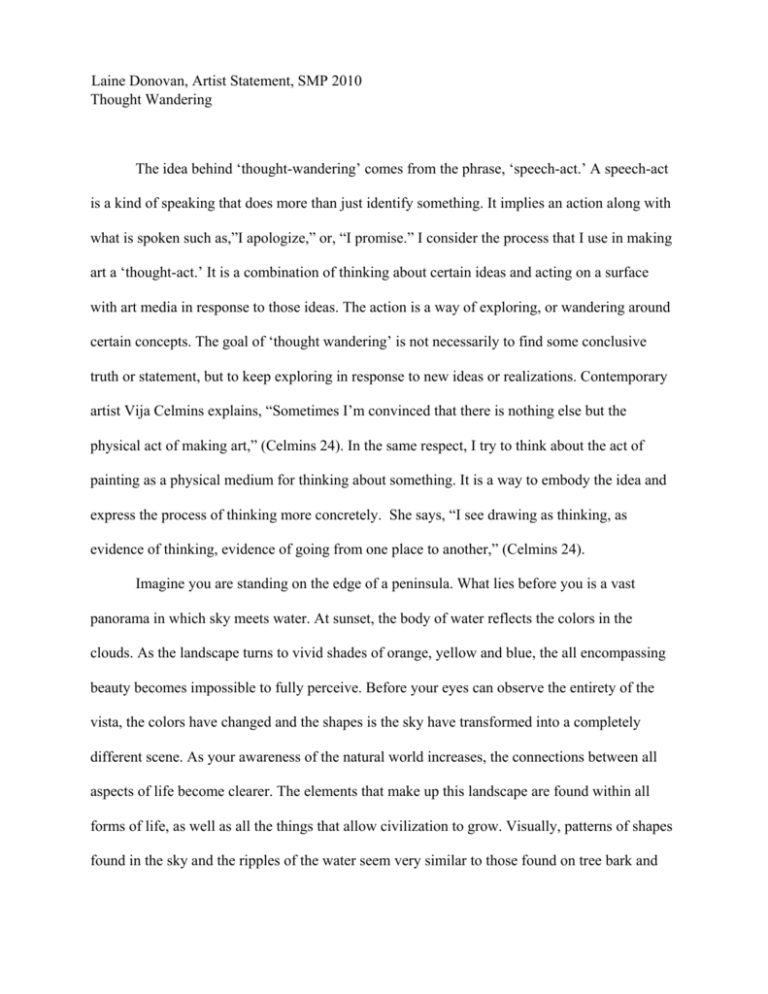
Laine Donovan, Artist Statement, SMP 2010 Thought Wandering The idea behind ‘thought-wandering’ comes from the phrase, ‘speech-act.’ A speech-act is a kind of speaking that does more than just identify something. It implies an action along with what is spoken such as,”I apologize,” or, “I promise.” I consider the process that I use in making art a ‘thought-act.’ It is a combination of thinking about certain ideas and acting on a surface with art media in response to those ideas. The action is a way of exploring, or wandering around certain concepts. The goal of ‘thought wandering’ is not necessarily to find some conclusive truth or statement, but to keep exploring in response to new ideas or realizations. Contemporary artist Vija Celmins explains, “Sometimes I’m convinced that there is nothing else but the physical act of making art,” (Celmins 24). In the same respect, I try to think about the act of painting as a physical medium for thinking about something. It is a way to embody the idea and express the process of thinking more concretely. She says, “I see drawing as thinking, as evidence of thinking, evidence of going from one place to another,” (Celmins 24). Imagine you are standing on the edge of a peninsula. What lies before you is a vast panorama in which sky meets water. At sunset, the body of water reflects the colors in the clouds. As the landscape turns to vivid shades of orange, yellow and blue, the all encompassing beauty becomes impossible to fully perceive. Before your eyes can observe the entirety of the vista, the colors have changed and the shapes is the sky have transformed into a completely different scene. As your awareness of the natural world increases, the connections between all aspects of life become clearer. The elements that make up this landscape are found within all forms of life, as well as all the things that allow civilization to grow. Visually, patterns of shapes found in the sky and the ripples of the water seem very similar to those found on tree bark and rock formations. The colors of a sunset become reminiscent of the changing leaves in autumn. This way of understanding the world is only my illusion of reality. Try to see the world from someone else’s eyes, and you will find it impossible to perceive. What may seem real to you is not necessarily the same as another person’s sense of reality, but that does not mean that either person’s perception is right or wrong. It just means that they are different. In making art, one can only represent his/her individual view; an illusion of how life can be understood. In fact, one may posit that all perceptions of reality are only illusions when compared to any other view, and I happen to believe that the illusion is what makes life interesting. A painting is both an object, and a representation or illusion of something else. In this way, painting inherently creates tension between dichotomous valuations such as what is real and what is an illusion. My work focuses on the way sensory and cognitive perceptions of the world vary. Commonly, there is a distinction placed between what is considered illusory and what is considered reality. The tension between ultimate reality (illusion) and the way in which we interact with and understand it is intrinsically tied to the idea of ‘emptiness,’ as it is defined in Mahayana Buddhism. This Buddhist tradition questions essentialism and the dichotomy between reality and illusion in a similar way as painting. Buddhist philosopher, Nagarjuna, uses the method of a four-prong negation to illustrate the way in which reality is ultimately a kind of illusion. Because all aspects of life are inherently connected, nothing can have essential or individual qualities. His argument collapses the plausibility of a concrete reality, full of definitions and dichotomies. Instead, everything becomes relative, completely impermanent and fundamentally illusionistic. Contemporary artist Vija Celmins’ creates a tension between illusionistic space and physical form. This tension is comparable to interests that I have with perceptual illusion and perceived reality. In discussing her works, she explains, “I wanted to make a work that was multi-dimensional and that went back and forth in space yet remained what it was: a small, concentrated area that was essentially flat,” (Celmins, 27). I am interesting in making an object that represents the illusion of a form through spatial depth, and a surface and structure that makes its physicality very apparent. In this way, I want to comment on the idea that illusion and reality are not dichotomous and concrete, but interrelated through a person’s own worldly and bodily perceptions. When a person views a work by Vija Celmins, it at firsts seems to be a composition full of repeated marks and strokes, bur a viewer soon realizes that the image is actually a carefully rendered naturalistic image. For example, Night Sky #2 (1991) appears at first to be a conglomeration of black and white gradations and dots. When the viewer becomes aware of the fact that it is an actual, (and exacting), image of a night sky, the image that first appeared to be incredibly flat opens up into infinite space. This experience of a work of art allows the viewers to “flex their perceptual muscles” (Weintraub 64), and begin to question ideas about reality that at one point seemed so stable. The graphite drawing, Untitled (Big Sea #2), (1969) has a similar affect. Like most of my works, Celmins does not use a horizon line to situate the viewer in an understandable space. Since the image is not necessarily identified immediately as a spatial representation of a landscape, the audience is forced to interact with the work differently, testing one’s perception and ideas about illusion. In addition to questioning the differences between reality and illusion, I explore questions related to essential qualities of nature from a Buddhist and Shinto perspective. Such qualities include nature’s constant changeability and the interconnectivity of all things. The Prajnaparamita Heart Sutra elucidates on the idea that are things are empty of any inherent essential quality, and therefore interconnected (Hanh 9). In The Heart of Understanding, Thich Nhat Hanh explains, “You can clearly see that there is cloud floating in this sheet of paper. Without a cloud, there will be no rain; without rain, the trees cannot grow; and without trees, we cannot make paper. The cloud is essential for the paper to exist.” (3) I consider this statement of the inherent connections between things both profound and worth exploration. I explore these connections through a process that involves translating images of nature into abstraction. I use abstraction as a means of visually demonstrating how elements of nature are interconnected. The forms I make come from multiple sources in nature such as, water, clouds, and tree bark. I use the repeating patterns found in these aspects of nature to create compositions that represent the landscape as an abstraction of all the elements in connection instead separate. I want my work to be understood as an image of nature, but not a specific scene. Both J.M.W. Turner and Georgia O’Keeffe have influence the way I use natural and abstract forms in my work. Heaped Thundercloud over Sea and Land (1835-1840) is a painting by Turner that begins to abstract the landscape. Turner produces a composition that is mainly based on gestural strokes of difference hues of gray. The image has the feel of a landscape, but does not represent a specific vista. A Valley in Switzerland (1842) by Turner is an image that comes even closer to the level of abstraction that I am interested in using in my work. The painting is composed of vague forms and a minimal color palette. Even though the image is ambiguous, it still reads as a landscape. In addition, Georgia O’Keeffe’s Series 1-From the Plains (1919) is a painting that is visually abstract, but feels like nature. There is an implied horizon and spatial depth that produces the illusion of a landscape without other concrete visual cues. The colors are not naturalistic and the forms seem distorted and expressive as opposed to descriptive. Although the forms I use are more representationally descriptive than the ones O’Keeffe uses, my work intends to imply something in nature without directly depicting what it is. I use long gestural stroke in order to evoke the idea of water, bark, or clouds, but my image never clearly (and individually) shows any of those elements of nature. Like these images, I am more interested in making paintings that portray the idea of nature as opposed to actual landscapes. I also abstract my images in an attempt to visually depict constant change from form to form over time, referencing the impermanence of all things in nature. Mono no aware is a Shinto concept that alludes to the fragility of beauty. In Shinto, a common example of mono no aware is the Cherry Blossom. The trees bloom for a very short period of time. Additionally, wind and rain can quickly strip the tree of the blossoms. In Japan, the transient nature of Cherry blossoms makes the beautiful event awe-inspiring and exceptional. I use this Shinto aesthetic connection to impermanence in my work. The images that I make have an elongated format that cannot be seen all at once. I use this scale and presentation in order to connect the way a viewer sees the art, and the way a person experiences a landscape. The viewer has to move his/her focus across the image over time, never being able to fully experience the complete essence of the scene. Similarly in nature, change that inevitably happens over time prevents an observer from perceiving all that nature has to offer within a single moment. In both Shinto and Buddhism, it is necessary for an individual to create a personal relationship with nature in order to fully understand its beauty, interconnectivity and changeability. People, as elements of the greater world, are also as connected to all of nature. One of my goals for my work is to encourage the viewer to re-immerse his/herself back into nature in order to wholly experience its wonder. When a person views my work, I want him/her to be reminded of nature, its transient beauty, and its connection to all things. Moreover, my work will hopefully incite the viewer to explore the outside world. Turner emphasizes the importance of personally experiencing nature in Heaped Thundercloud over Sea and Land (1835-1840). This painting is believed to have been created on plein air, or outside within the depicted landscape (Townsend 132). By placing himself in nature, Turner is able to more fully capture to essence of the scene. Georgia O’Keeffe’s abstract paintings present forms in nature in a way that makes a viewer consider their relation to the surroundings as well as the relation to the viewer’s own perceptions of nature. In Pelvis IV (1944), O’Keeffe uses these three methods of abstraction to change the way a viewer perceives a realistically rendered painting. She does not show the viewer the entire shape of the pelvis bone, and she increases the scale to be larger than life size. The simplicity of the form, as well as the exaggerated scale turns the pelvis into more than just a bone, but a symbol or indicator of a place and an experience. Additionally, the bright and pure blue of the sky behind the bone increases the emotional effect of the image. The painting feels like a lonesome desert that is not dead (as the bone could signify), but very much alive in its wonder and emotional affect. The painting is specific to a place and emotion, but open to the audiences understanding of the feeling that it provides. The emotional nature reflects a viewer’s own experiences, not just those of Georgia O’Keeffe. Similar to O’Keeffe’s paintings, my work comes from a specific location that is currently central to my life (St. Mary’s, Maryland). For example, in the series of panels I use trees that are found all over campus. Still, the image is not so specific that it only exists within the local context. Through the medium of painting, I am able to express my experiences within the natural world. It allows me to think about, question and explore aspects of nature, and to meditate on the way it affects my understandings of the world. My intension is to create a body of work that will visually convey my thought wanderings. Furthermore my work will hopefully motivate the viewer to contemplate on essential qualities of nature, and live more harmoniously within it. Works Cited: Clemins, Vija. Interview with Chuck Close. Between Artists. Los Angeles: A.R.T. Press. 1992. Hanh, Thich Nhat. The Heart of Understanding: Commentaries on the Prajnaparamita Heart Sutra. Berkeley: Parallax Press, 1988. Townsend, Richard P. J.M.W. Turner, "that greatest of landscape painters" : Watercolors from London Museums. Tulsa: University of Washington Press, 1998. Weintraub, Linda. In the Making. New York: Distributed Art Publishers, Inc., 2003. Art Works: Georgia O’Keeffe, Pelvis IV, 1944. Georgia O’Keeffe, Series 1- From the Plains, 1919. J.M.W. Turner, Heaped Thundercloud over Sea and Land, 1835-1840. J.M.W. Turner, A Valley in Switzerland, 1842. Vija Celmins, Untitled (Big Sea #2), 1969. Vija Celmins, Night Sky #2, 1991.
